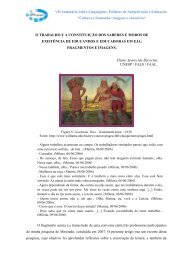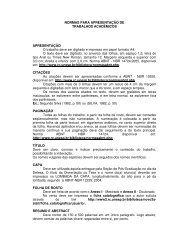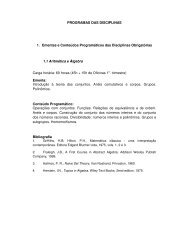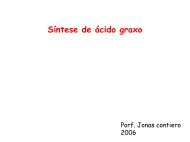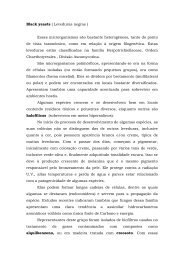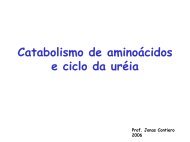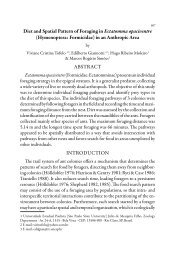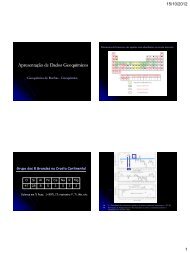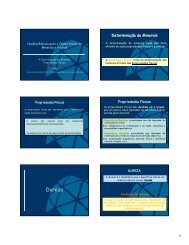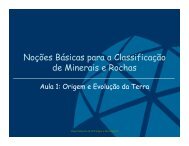Create successful ePaper yourself
Turn your PDF publications into a flip-book with our unique Google optimized e-Paper software.
II Encontro dos Programas de Pós-Graduação em Geociências, 2008<br />
PALEOVERTEBRATES FROM THE GOIÁS STATE<br />
PEDRO OLIVEIRA PAULO<br />
E-mail: pedro@rc.unesp.br<br />
Orientador: Prof. Dr. Reinaldo José Bertini<br />
The Paleozoic strata, in the Goiás State, containing fossil vertebrates, up to now are<br />
restricted to the Irati and Corumbataí formations. The first one, from the Lower Permian<br />
Period, have yielded a vast number of mesosaurid remains. The second, Middle Permian<br />
in age, also outcrops on Central Goiás State, presenting some isolated and fragmented<br />
undescribed fish remains (teeth and scales).<br />
There are some areas in Brazil where, considering Upper Cretaceous strata, show<br />
several representative remains of a significative biotic diversity. One of the most<br />
important of these areas is the Bauru Basin, divided in two lithostratigraphic units,<br />
named Caiuá and Bauru groups. As one of the most expressive continental fossil<br />
assemblages from Brazil, the Bauru Group contains fossils associated to strata formed<br />
in depositional enviroments, mainly fluvial and lacustrine, covering areas in the states<br />
of Goiás, Mato Grosso, Mato Grosso do Sul, Minas Gerais, Paraná and São Paulo. The<br />
Bauru Group has an expressive occurrence on the Southern-Central portion of the Goiás<br />
State, where there are some Adamantina and Marília Formations outcrops. The<br />
Adamantina Formation has furnished several remains of vertebrate fossils, such as<br />
fishes, testudines, lacertilians, crocodyliforms, theropodomorphs, sauropods and<br />
mammals, from Minas Gerais and São Paulo states. Otherwise the Marília Formation<br />
occurs in the states of Goiás, Minas Gerais, and São Paulo. It has been rich in fossil<br />
remains, representing a wide array of taxons, such fishes, testudines, crocodyliforms,<br />
maniraptoriforms and sauropodomorphs. Despite both Marília and Adamantina<br />
formations, rich in fossil vertebrates, occur in the Goiás State, the fossil record related<br />
to these Cretaceous sequences only mentions some fossil localities, presenting citations,<br />
not descriptions of materials, about remains associated to theropodomorphs and<br />
sauropodomorphs. Therefore in these circumstances one may suppose that there are<br />
some regions on Southern-Central Goiás State that could shelter interesting<br />
prospectable vertebrate fossil outcrops. Then detailed searching and prospecting in these<br />
litostratigraphic units of the Bauru Basin, on the Goiás State, could yield new fossil<br />
remains, aiding to improve our understanding of the paleoecological, biochronological,<br />
paleobiogeographical comparisons to the vertebrate faunas previously revered in the<br />
Bauru Basin, especially from Minas Gerais and São Paulo states. In the same way it<br />
would also permit paleoecological, biochronological, paleobiogeographical<br />
comparisons to the Cambambe Group area, not associated to the Bauru Basin, located<br />
on the Mato Grosso State, until now not well known.<br />
Besides there are some areas, in the Goiás State, that have furnished some remains of<br />
fossil mammals, from both Pleistocene and sub-Holocene epochs.<br />
So this study aims to outline the vertebrate fossil fauna of this part of the Central Brazil,<br />
comprehending Permian and Cretaceous periods, besides Pleistocene Epoch. All<br />
bibliographic records about these groups, as well as detailed analysis of the housed<br />
materials in some institutional collections spread through Brazil, will improve our<br />
knowledge and understanding of the fossil vertebrates occurrences in the Goiás State,<br />
81




